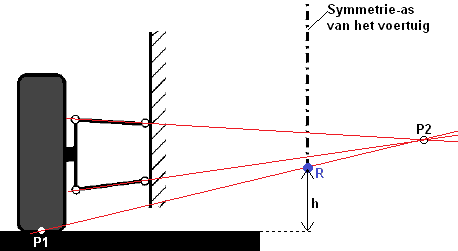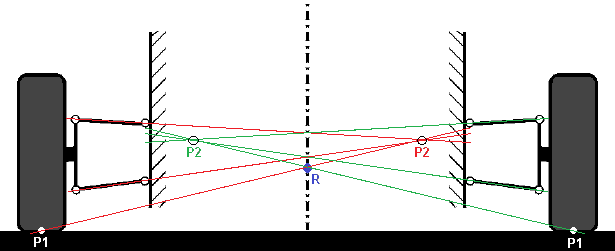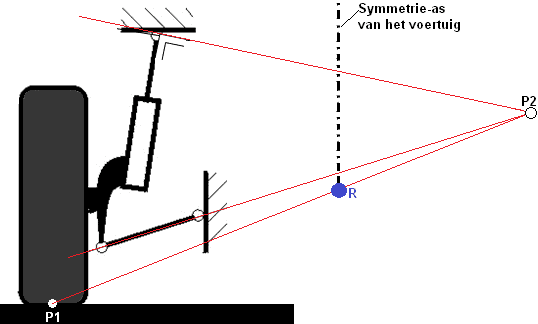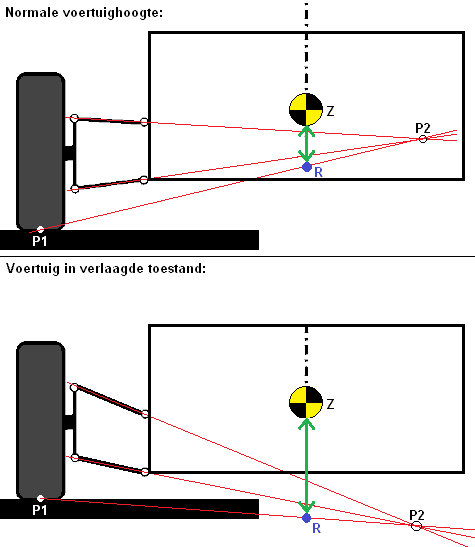Subjects:
- Role Center
- Influence of lowering on the roll center
Role Center:
Every vehicle has a roll center. The construction of the wishbones and springs determine the height of the roll center (the roll axis), which is responsible for the tilting or rolling of the superstructure. On modern cars, the roll axis is usually located slightly below the center of the wheels, almost parallel to the road surface and as close as possible to the car's center of gravity. The distance between the center of gravity and the roll axis should be as small as possible, in order to keep the "rolling effect" as small as possible. More on this is explained in the next chapter on this page.
To limit rolling, the stabilizer, suitable shock absorbers and springs with the correct spring characteristics are used.
The roll center of a vehicle is determined from points P1 and P2 (see picture on the right), which are calculated by (imaginary) lengthening of the springs / wishbones (see pictures). By extending both wishbones, the point P2 is found (where the lines intersect). Then the line can be drawn from point P1 (the middle of the tire road surface contact) to the previously found point P2. The roll center R is now on the vehicle's axis of symmetry (the exact center).

In order to clarify this image more, the right wheel has also been drawn in the image on the right with the corresponding lines. It can be seen here that the roll center is at the same point, because the vehicle is completely symmetrical. This means that both the left and right sides of the vehicle are the same.

This image shows the situation with a McPherson strut. The top line should be perpendicular to the shock absorber. The line below is drawn through the wishbone, up to the point where it intersects the top line. This is the common point P2. Then the line P1 is drawn from the center of the belt to P2. The roll axis R lies on the line from P1 to P2, exactly on the axis of symmetry of the vehicle.

Influence of lowering on the roll center:
Lowering a car has negative effects on the roll center. If the roll center moves too far and there is too much distance between the center of gravity of the car and the roll axis, the vehicle will roll more on its axis. Various measures must then be taken to ensure that the driving characteristics do not deteriorate, such as;
- Shock absorbers with a higher damping factor
- Springs with a stiffer spring characteristic
- Stabilizer (possibly a stiffer one than original)
The images on the right show two different situations; the top one from a non-lowered car and the bottom one from a lowered car. The center of gravity (Z) indicated by the yellow-black marking moves downwards proportionally with the vehicle. The distance between the two vehicles (indicated by the green arrow) has increased considerably.
In the lowered position, the roll center lies in the road surface.
This is done deliberately with track cars. The roll center is then 2 to 3 cm in the road surface. The entire chassis has been adapted to this (springs, shock absorbers and stabilizer). If this is not done (by mounting only lowering springs), the greater distance (the green arrows) will cause the center of gravity (Z) to tilt around the roll axis (R). This creates a kind of force x arm situation.
There are conversion options, whereby the wishbones on the steering knuckle body come to lie more horizontally with large ball joints. The roll center then comes closer to the center of gravity. In the latter case, the center of gravity is lowered with lowering and has no negative impact on the roll center. In this way, the driving characteristics will be greatly improved.

More information about wheel positions and adjustments can be found on the page wheel geometry.
